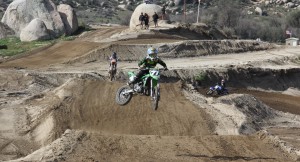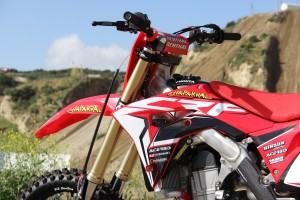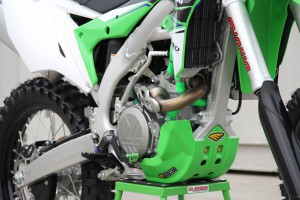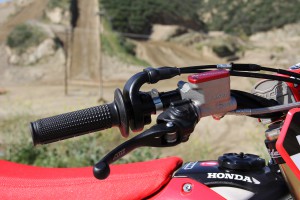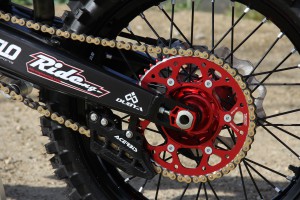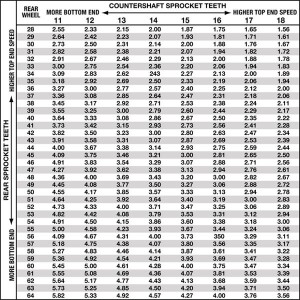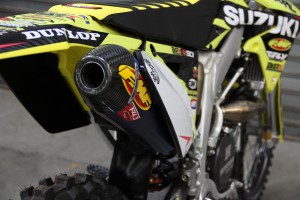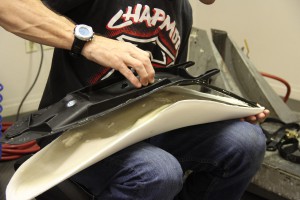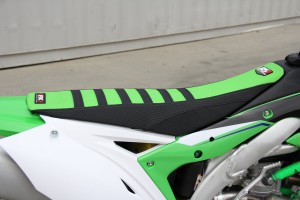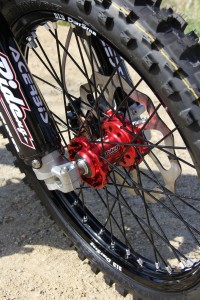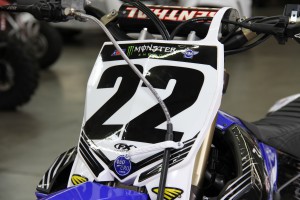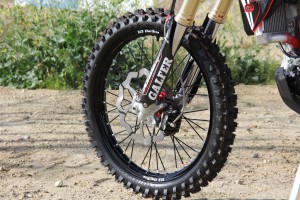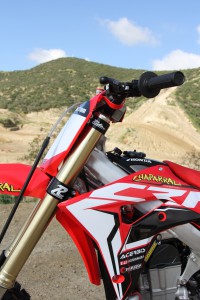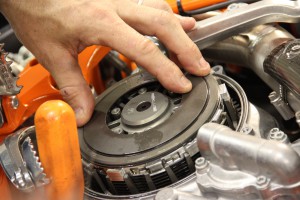10 Ways To Fall Back In Love With Your Dirt Bike
Remember the day you brought your dirt bike home from the dealership and you were so excited? Everything was bright, shiny, new, and most importantly in good working order. Then as time went on and your put more and more laps and hours of riding time into the bike it started to lose its luster as parts got scratched up, bent, or just downright broken.
It happens to the best of us, not that we lose our passion for our dirt bikes, but just like anything, when you spend enough time with it you tend to get a little bored or maybe some of the excitement slips away. One of the best ways to rekindle the fire and help you feel those same butterflies you did when you first got your dirt bike is to change things up. It doesn't have to be a complete tire to tire makeover, sometimes just an upgrade here or there or even trying a new product can give your bike a fresh new look, make it feel like an all-new machine, or help it perform significantly better-and put a huge smile on your face.
Below we have listed ten things you can do that can help you fall back in love with your dirt bike.
1. Graphics/Plastics
When you first threw a leg over your dirt bike the stock graphics were pristine without a single scratch or scuff and your plastics were in perfect shape. More than likely it only took a few rips around the track before a roost or two from your buddy changed all that. A little wear and tear on the graphics and plastics isn't necessarily a bad thing, it does show that you actually ride your dirt bike, but after a while you might want to change things up a bit.
Swapping out your stock graphics is like getting a new tattoo; it's still the same skin underneath it's just a bit flashier now. There are plenty of pre-designed stickers and graphic kits from companies like Factory Effex with themes like Monster Energy, Metal Mulisha and even factory team replicas so you can represent your favorite racer. Another option is to contact a company like Magik Graphics and have them make you up a one off set of graphics that feature your sponsors or favorite color schemes.
If slapping on new graphics is like getting a tattoo then changing out your dirt bike plastics is sort of like going under the knife for plastic surgery; it's still the same bones underneath it's just that the exterior shapes and contours of the skin looks a little different. In some cases, if you have an older bike you can give it face lift and make it look younger look by replicating the style or colors of the latest model. Some people may want a complete pigment change and go for some flo-yellow plastics or take a trip to the dark side with all black plastics.
Besides a cosmetic change, another route to go with plastics would be to add a complete protection setup. Up front you might add a Cycra Factory Edition Stadium Number Plate to help cover your lower triple tree or you can cover your front rotor to help keep rocks, sticks, and dirt from damaging/interfering with your braking system. If you have a painted frame or even a raw aluminum frame you know how much damage your boots can cause to the sides of the frame as your ride. A set of frame guards will not only protect the frame but with their rubber inserts the Acerbis X-Grip Frame Guards will provide additional grip. Your bike probably came with a chain guide and slider but chances are the plastic material is pretty thin and may even be worn down. You can beef things up with a new chain guide block and slider. Companies like Acerbis and T.M. Designs sell the parts in a variety of colors and you can purchase the chain guide and slider separately or get them in a kit.
Lastly, if you do a lot of offroad riding or you're going to be on a muddy track then a skid plate can come in real handy to protect your engine and keep mud from building up. Hand guards are a good idea to protect your hands from roost and trees when trail riding.
2. Controls
More than likely you've gone down a few times on your dirt bike and more than likely your hand controls have taken a beating. Installing levers that can fold and rotate in the event of a crash can save you the headache of dealing with broken levers. If you've been experiencing arm pump then you might want to try swapping out your dirt bike grips or even the handlebars. Moving to a dual compound material or even a half waffle pattern could help relieve some stress in your forearms or hands. A different bar bend or height can not only help with arm pump but slightly change up your hand positioning to provide a more comfortable ride and possibly improve handling.
Down below, you could benefit from a wider footpeg platform for more control or sharper teeth for better grip. Flo Motorsports' Pro Series Footpegs offer a little bit of both with a large platform that measures 57mm wide and 75mm long and replaceable stainless steel teeth.
3. Chain/Sprocket
Changing up the gearing is probably one of the fastest, easiest, and least expensive ways you can breathe new life to your bike. If you spend a lot of time on your dirt bike you're eventually going to have to change your sprockets and/or chain because they are wear items that will need replacing over time. But if you're going to be replacing parts, why not spice things up at the same time. By simply changing out your dirt bike sprocket with a taller or lower gearing setup you can really change the performance of your motorcycle.
We have posted about drive ratios and dirt bike gearing changes before and you can read more about it here. Long story short, you are either gearing up or gearing down when changing out the smaller counter shaft sprocket or the larger rear sprocket. Because of its size and more teeth, it's often best to change out the rear sprocket, as it will allow you to get more finely tuned adjustments. Changing your dirt bike's drive ratio is a compromise between top end speed and low end torque, so you need to determine ahead of time what will be best for your riding style, track conditions, or the goal you are trying to achieve. The basic rule is if you want more top end speed then you'll want to gear up with a smaller rear sprocket. If you want more low end power for better hole shots and acceleration out of corners then you'll want to gear down with a rear sprocket that has more teeth.
When changing the gearing it's best practice to also install a new chain at the same time. This will improve overall performance of the parts as they wear in together. Also, if you make big leaps in your sprocket sizes then you may need a longer or shorter chain to accommodate the changes.
4. Exhaust and Intake
Everybody loves the sound of a dirt bike, but if your still running the stock exhaust system you might not be getting the sound and performance you desire. A new two stoke pipe or upgrading your four stroke dirt bike exhaust can make a world of difference. If you don't want to do a full system swap, there are still plenty of benefits from simply installing a new slip-on. In most cases an aftermarket slip-on from a company like FMF or Yoshimura will weigh less than stock, deliver a more performance oriented sound, and probably add a couple of extra horsepower and torque points.
If times are tight and you don't have the money to spend on a full system, silencer, or slip-on then consider at least repacking your muffler. Over time the stock packing in your muffler gets burnt up, wears down or gets blown out, all of which can reduce the performance of your bike. Installing fresh muffler packing can make quite a bit of difference in your dirt bike and help it perform like brand new again.
5. Tires
There's a lot of science and testing that goes into those round black things at either end of your dirt bike. If you just automatically re-shoe your dirt bike wheels with the same tires that came stock on your bike then you're missing out on a whole world of excitement. When it comes to choosing dirt bike tires the three most popular terms you'll come across are: soft terrain, hard terrain, and intermediate terrain. Like the names imply, these motorcycle tires are designed for a specific type of terrain/riding conditions. There are a couple others such as paddle tires, sand tires, and offroad tires.
Which is right for you? Well it all depends on a few things: the track or area where you'll be riding, the type of soil you'll be riding, and how well or often the track is prepped. If you can answer these questions you'll have a really good idea as to what kind of tires you should outfit your dirt bike with.
-
Soft Terrain
Has it been raining lately? Does the track crew tend to overwater? Is the dirt soft and fluffy and easily gives away as you push into it? If you ticked these off then you'll be looking at a set of soft terrain tires. These tires have taller knobs that may vary in height and/or have slight peaks or angles to them-especially on the outer edges. The knobs on a soft terrain tire are designed to be stiff so that they can dig and cup into the terrain to provide traction in loose, loamy dirt or muddy conditions. A wider spaced knob pattern makes it harder for dirt and mud to get caught up in between the knobs and when it does this design allows for the debris to easily get flung out. Using a soft terrain tire on hard/rocky conditions can cause the tire to chunk, meaning knobs will get torn up or ripped off and can can cause the tires to wear out prematurely.
-
Hard Terrain
Are you hitting the trails? Has it been really hot? Is the dirt in the area dry, gritty, or hard pack? Those are ideal conditions for hard terrain tires. You might not find too many situations to use Hard terrain tires on a motocross track, they more common among trail riders and GNCC/Hare and Hound enthusiasts. Characteristics of most hard terrain tires are shorter knobs with a flatter profile for better consistency and grip, as well as a smoother ride. Since there most likely won't be a lot of loose dirt to get caught up between the knobs, the knobs are spaced closer together to provide more surface area and grip.
These tires often feature softer/stickier compounds that help provide extra traction on the harder surfaces. This softer compound allows them a bit of flex to move across the hard pack and provide a broader footprint on the surface. The sidewall is also a bit stiffer so that the tire holds its form in a turn and can withstand the torment of the hard surface. One misconception people assume when it comes to selecting dirt bike tires is they think the harder compound tires will last longer (like street tires) which is not the case with dirt tires.
-
Intermediate Terrain
If you're not too sure what you're getting into then intermediate tires may be the way to go. Sort of like the Goldilocks of dirt bike tires, intermediate tires do a lot of things well and can get you through you all types of conditions and terrain. While intermediate tires are very versatile and can handle mud, soft dirt, and hard pack, they do tackle these conditions with some compromise in certain areas i.e. they may not self-clean as well as soft terrain and won't grip as well as hard terrain on blue grooved sections.
The nice thing about intermediate tires is that most manufacturers offer intermediate-hard and intermediate-soft tires which as the name implies delivers a broad range of performance for a myriad of conditions but performs even better in certain types of terrain as opposed to standard intermediate tires. You'll notice that a lot of motocross racers use soft-intermediate tires these days because the track prep crews like to till the dirt fairly deep before racing.
6. Seat (foam/cover)
There are many reasons to change out your seat and the cover. Over time the foam in your seat will soften up or possibly even completely break down causing loss of padding and discomfort. If you're just not comfortable on your bike or want to change up the riding position you can pull out your stock seat foam and install taller, wider, lower, or even add a slight hump to suit your needs. Taller seat foam can be useful for taller riders by reducing the distance between the seat and rider's butt when standing-thus reducing the effort/energy it takes to stand and sit. For a shorter rider they may find that the stock seat is constantly doing a number on their junk when standing, therefore a shorter seat would provide a larger gap. Companies like Factory Effex offer a wide array of seat foam styles for your dirt bike such as wide seat foams and taller foams.
If you're seat cover is starting to show some wear or you just can't get that hole shot because you're constantly slipping off the back of your bike it's time for a new seat cover. Adding some grip to your seat will make a world of difference to your riding performance. The Factory Effex RS1 Seat Cover not only provides an extra-grippy surface with its textured material, but the strips of traction panels over the top of this dirt bike seat cover help keep your butt in place. The other nice thing about changing up your seat cover is it allows you to add some color and another level of customization to your bike.
7. Wheel Set
If you've taken a hard crash or two, you may want to check out your dirt bike wheels; they may not be as true as when they came from the factory. Your wheels can take a lot of abuse so it's important to inspect them regularly, make sure the lip of the rim is in good shape, the hubs and bearings are in good working order, and all of the spokes are tight. Even if your wheels are good, if you're looking to take your racing to the next level and wanting to shed weight, you may find that aftermarket wheels that are lighter or stronger than your stockers. Or maybe you want some red ano hubs mixed with black rims? Whatever the reason, getting a hold of some new dirt bike wheels can really dress up your ride and in some cases depending on what you get can help improve your overall performance.
Companies like DID and Talon are well known in the industry for making some great wheel components like billet hubs, extremely durable aluminum rims, and stainless steel spokes. Then you've got the guys over at Dubya USA who are masters at putting together some great combinations of style and performance.
8. Brakes (oversize rotor/steel braided lines)
As much as racing a dirt bike is about going fast, it's equally important to be able to control all that speed. That's where a quality braking system comes into play. Upgrading to stainless steel brake lines or even an oversized brake rotor can make improvements to your motorcycle that you can actually feel. Over time rubber brake lines can break down and become worn to the point that they expand under the pressure applied from the fluid being squeezed through them, causing your brakes to feel spongy.
Your brake lines take a lot of abuse from flying rocks, collisions, and sun/weather damage all of which can lead to cracks or worse, leaks. By installing steel braided brake lines not only will your brakes perform much better but they'll also be better protected. By running steel braided brake lines, like those offered by Galfer, you'll notice a more consistent and positive feel at the lever every time you hit the brakes. This is due to the fact that there is braided steel material that is wrapped around a Teflon inner hose (where the fluid flows through) and the braided steel keeps the line from expanding-thus eliminating that spongy/soft feeling. Galfer also wraps the braided stainless with a UV resistant PVC coating on the exterior which adds yet another level of protection to the brake lines.
When installing new brake lines you might as well upgrade your rotors as well. This move will really help you get the most out of your braking system. Whether you're looking to cut weight, or boost your braking there's a few ways you can go such as solid or floating rotors. Galfer's Wave rotors design have been a very popular choice due to their ability to dissipate heat through their multi faced surfaces and proprietary steel material that aids in excellent braking performance.
If you really want to change things up on your dirt bike, Galfer's Tsunami Oversize Rotor Kit comes with a 280mm Wave rotor and a relocating bracket to properly space out your caliper for the larger rotor. The benefit of running an oversize rotor is even more surface area which provides better heat management and dissipation, a better feel at the brake lever and more brake torque.
9. Triple Clamp
It can be a pricey upgrade, but some people have really noticed an improvement in the handling and their overall satisfaction by ditching the stock triple clamps and upgrading to something from the aftermarket like one of the offerings from Ride Engineering. If you're not happy with your bike's handling and cornering then maybe it's time to consider changing out your triple clamps for a different offset other than whatever came stock on your dirt bike. For most year, make, and models Ride Engineering offers a couple of different offsets, typically 20mm, 21mm, 22mm, or 23mm.
Besides the ability to change up the handling via different offsets, Ride Engineering's triple clamps are little lighter than stock (depending on your bike) and in some cases offer more flex. One really nice thing about the options from Ride Engineering is that the lower clamps feature mounts machined into them making it easy to install a steering head stabilizer. Selecting the offset that is right for you is a matter of preference and every rider will have a different riding style, so it's a matter of figuring out what you like don't like. If you're not sure which direction to go check in with whatever company manufactures the setup you're interested in or check with your local shop for their recommendations.
10. Rekluse Clutch
Installing a Rekluse EXP 3.0 auto clutch in a dirt bike is a major upgrade that can benefit new riders as well as experienced racers and expert riders. The ability to ride without having to worry about stalling the bike and make fast speed gear changes without having to operate the clutch lever allows riders to focus their attention on other things like braking, cornering, and the track ahead.
The basic concept behind the clutch setup is that it utilizes centrifugal force to engage the clutch. Upon start up, with low rpms you can tap the bike into gear without pulling in the clutch lever and you won't have to worry about the bike lunging forward and stalling. Then as you apply more throttle and the rpms increase, the clutch design expands and more force is applied and eventually the clutch engages and provides the drive to propel the bike.
You can still operate the clutch as you normally would and if you're into clutch-less shifting you can still do that as well. One thing that many people like about the Rekluse clutch is that it makes it hard to stall the bike which can be very handy in the event of a crash. After using one of Rekluse's clutch setups many riders have seen their confidence significantly increase which has also led to improved riding ability and lap times as well.

